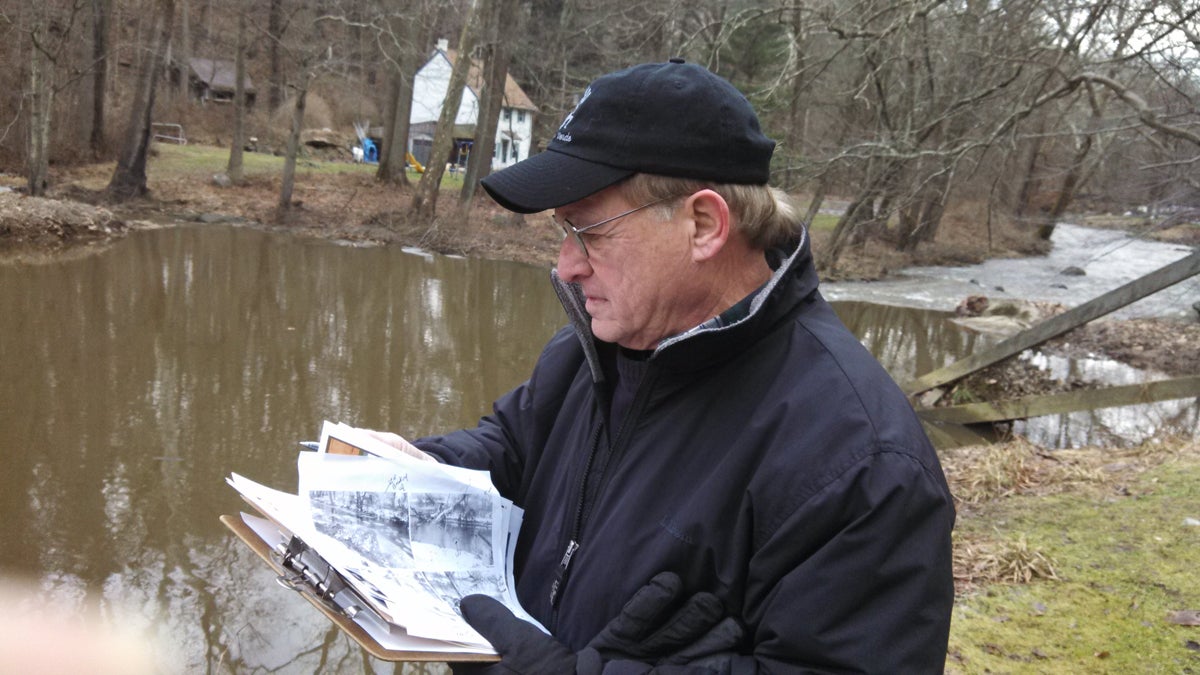What can local bodies of water tell us about climate change?
Listen
IceWatch USA volunteer Bob Berke prepares to measure ice in Delaware County. (Kimberly Haas/for The Pulse)
A group of citizen scientists are measuring local ice in hopes of contributing to a bigger understanding of climate change.
Concerns about climate change often focus on melting ice: glaciers are receding, polar bears are losing their frosty habitats, and our winters seem to be getting warmer, the recent cold snaps notwithstanding. IceWatch USA, a national project enlisting citizen science volunteers to measure ice over the course of the winter, is collecting data to quantify those changes.
Volunteer ice watchers first select a body of water that’s accessible to them during the winter. It could be a lake, a pond, or a stream. They collect data at that site, which is then crunched and analyzed by scientists who study climate change and other environmental issues.
How it’s done
Bob Berke is an IceWatch volunteer in Delaware County. He’s in his 70s and living a life of “serial volunteerism.”
“So we’re standing at the falls in Ridley Creek State Park,” Berke says on a cold winter afternoon. “There’s a small island in the middle. Last week the falls were frozen.”
Berke measures the ice from the shore to the island, and he found that the best way to record the thickness is with a camera. “You get a quick view, and you don’t have to stand and freeze to death,” he laughs.Berke records the date, time, air temperature, and location in latitude and longitude. Volunteers also track all types of wildlife and waterfowl at their site during the winter.
IceWatch USA launched in 2008 and has grown to include volunteers in 48 states, all but Hawaii and Alabama.
According to Melinda Hughes-Wert, the program’s director, the upcoming five-year anniversary is significant.
“You need a longer period of time to really see what’s going on,” says Hughes-Wert, “because it fluctuates so much with the winter season and the temperatures, and the jet streams coming down from the Arctic, and you have the nor’easters coming up the coast. You have a lot of variances that you don’t have regularly throughout the year.”
Contributing to a larger picture
Though IceWatch is very specific in its goals, it has a broader reach when its collected data joins with other projects.
“So we can look at something as finite as Ice Watch, or projects that ask people to measure precipitation–rain, snow, hail,” says Darlene Cavalier, founder of the website SciStarter.com. “It seems very limited, what you’re being asked to do. But the fact is, many of these projects feed into larger projects. I love seeing this cross-pollination of citizen science projects that can help inform areas of research across disciplines.”
To that end, ice watch is part of the National Phenology Network, a group of scientists who study life cycle events in animal and plant species, like when water fowl migrate, or when a trees’ leaves fall, and how they’re affected by environmental changes.
Hughes-Wert says one goal is to standardize methods of collecting and tabulating data, to facilitate sharing: “We’re working on making sure that all the volunteers across the board have similar ways of entering data so the information from different groups can be used together to analyze climate change and other environmental indicators.”
Besides Berke with Ridley Creek in Delaware County, IceWatch USA also has volunteers watching Mill Creek in Bucks County and the Millstone River near Princeton. Philadelphia area bodies of water on their wish list include the Schuylkill River, Brandywine Creek, and the Mullica River.
WHYY is your source for fact-based, in-depth journalism and information. As a nonprofit organization, we rely on financial support from readers like you. Please give today.



